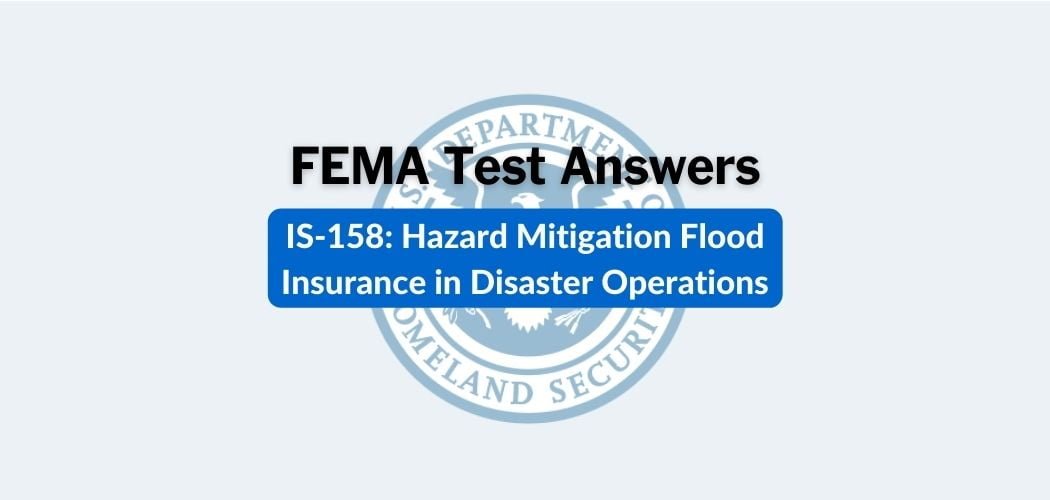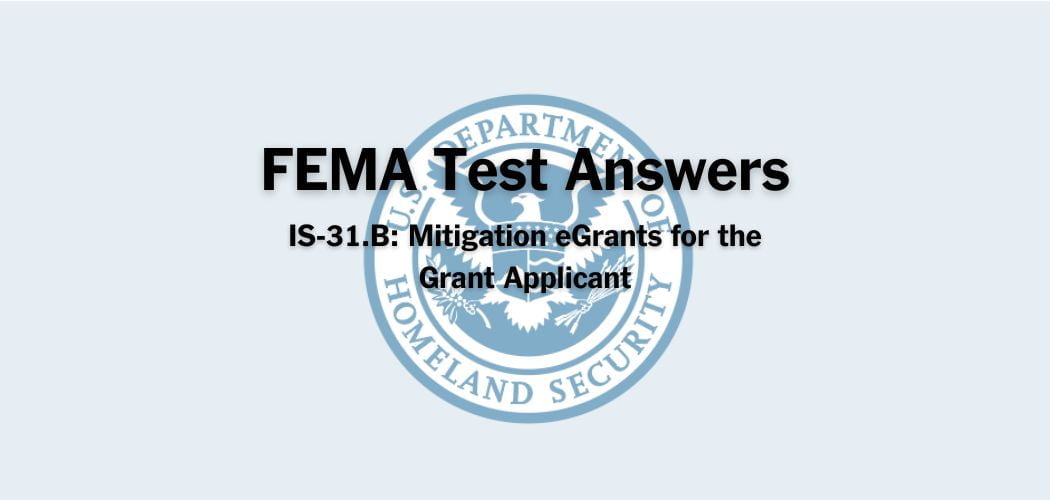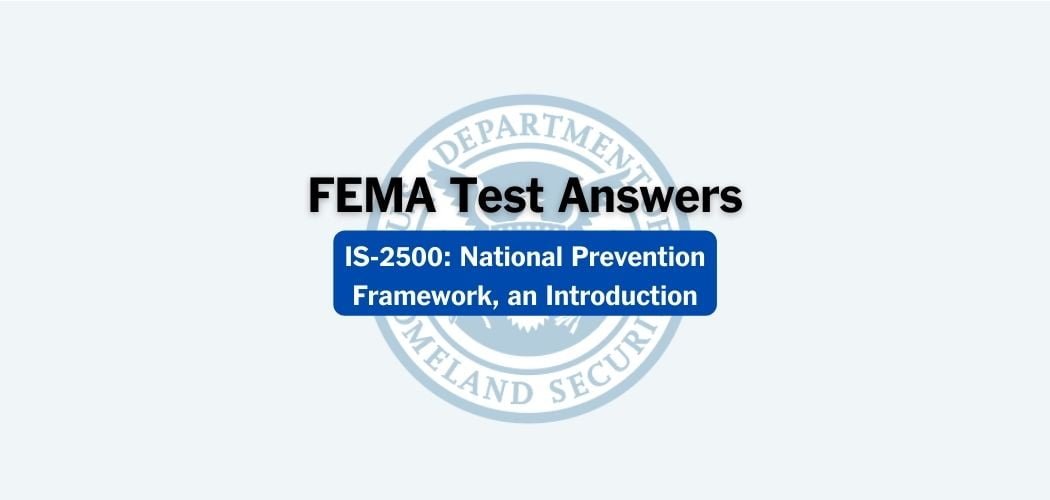Overview: The FEMA IS-100.C course was published on 6/25/2018 to introduce the Incident Command System (ICS) and provide a foundation for higher-level ICS training. This course describes the history, features, principles, and organizational structure of the Incident Command System.
Primary audience: FEMA IS-100.C is for all people involved with emergency planning, and response or recovery efforts. There are no prerequisites.
FEMA IS-100.C test answers
Question 1. The number of subordinates that one supervisor can manage effectively during an incident is referred to as:
A. Unity of Command
B. Manageable Span of Control✅
C. Modular Organization
D. Management by Objectives
Question 2. Check-in, Incident Action Planning, Personal Responsibility, and Resource Tracking are all necessary to ensure:
A. Redundancy
B. Accountability✅
C. Sustainability
D. Flexibility
Question 3. Which one of the following activities is not an example of incident coordination?
A. Directing, ordering, or controlling.✅
B. Establishing priorities among incidents.
C. Synchronizing public information messages.
D. Resolving critical resource issues.
Question 4. Depending on the incident size and complexity, various types of support facilities may be established by:
A. Incident Command✅
B. Local Authorities
C. the Logistics Section
D. the Planning Section
Question 5. In a Unified Command, members representing multiple jurisdictions and agencies work together to establish:
A. Shared Agency Authority
B. Incident Objectives✅
C. Resource Allocations
D. Situational Awareness
Question 6. Selection of Incident Commanders is done by the:
A. Planning Officer
B. Emergency Operations manager
C. Public Information Officer
D. Jurisdiction or organization with primary responsibility for the incident✅
Question 7. The Incident Command System (ICS) is:
A. Most applicable to the management of complex incidents that extend over many hours or days.
B. A standardized approach to incident management that is applicable for use in all hazards.✅
C. A military system used in domestic incidents to ensure command and control of Federal resources.
D. A relatively new approach created based on the lessons learned from the 9/11 terrorist attacks.
Question 8. Which General Staff member is responsible for ensuring that assigned incident personnel are fed and have communications, medical support, and transportation as needed to meet the operational objective?
A. Planning Section Chief
B. Safety Officer
C. Public Information Officer
D. Logistics Section Chief✅
Question 9. Which ICS functional area arranges for resources and needed services to support the achievement of the incident objectives?
A. Finance/Administration
B. Operations
C. Logistics✅
D. Planning
Question 10. Which ICS functional area monitors costs related to the incident and provides accounting, procurement, time recording, and cost analysis?
A. Finance/Administration✅
B. Operations
C. Logistics
D. Command
Question 11. Who designates the process for transferring command?
A. The Command Staff
B. The Incident Commander for the previous operational period
C. The jurisdiction or organization with primary responsibility for the incident✅
D. The Section Chiefs
Question 12. If the Incident Commander designates personnel to provide public information, safety, and liaison services, the personnel are collectively referred to as the:
A. Command Staff✅
B. Incident Staff
C. Executive Staff
D. Director Staff
Question 13. How many NIMS Management Characteristics are there?
A. 12
B. 13
C. 14✅
D. 15
Question 14. Who has overall responsibility for managing the on-scene incident?
A. Operations Section Chief
B. Agency Executive
C. Incident Commander✅
D. Emergency Operations Center Director
Question 15. Incident objectives that drive incident operations are established by the:
A. Agency Administrator
B. Operations Section Chief
C. Incident Commander or Unified Command✅
D. Planning Section Chief
Question 16. Qualification, Certification, and Credentialing Personnel are part of which NIMS Management Characteristic?
A. Information and Intelligence Management
B. Comprehensive Resource Management✅
C. Incident Facilities and Locations
D. Accountability
Question 17. To ensure efficient, clear, communication, the National Incident Management System Characteristics recommend the use of:
A. Acronyms
B. Agency-specific codes
C. Technical language
D. Common terminology✅
Question 18. Which General Staff member directs all responses and tactical actions to achieve the incident objectives?
A. Operations Division Director
B. Operations Section Chief✅
C. Tactics Section Chief
D. Planning Section Chief
Question 19. The Incident Commander or Unified Command establishes incident objectives that include:
A. Establishing a manageable span of control.
B. Selecting personnel to serve on the Incident Management Team.
C. Delegating functional responsibilities and specifying resource types.
D. Identifying strategies, tactics, tasks, and activities to achieve the objectives.✅
Question 20. Which NIMS Management Characteristic is necessary for achieving situational awareness and facilitating information sharing?
A. Integrated Communications✅
B. Comprehensive Resource Management
C. Chain of Command and Unity of Command
D. Accountability
Question 21. Which Section organizes, assigns, and supervises tactical response resources?
A. Finance/Administration
B. Operations✅
C. Logistics
D. Planning
Question 22. Which ICS functional area tracks resources, collects and analyzes information, and maintains documentation?
A. Finance/Administration
B. Operations
C. Logistics
D. Planning✅
Question 23. The Liaison Officer:
A. Is the point of contact for other response organizations.✅
B. Tracks resources and maintains incident documentation.
C. Provides information to the public.
D. Arranges for resources and needed services to support the incident objectives.
Question 24. To ensure a smooth transfer, the outgoing Incident Commander should provide a(n) _______ to the new Incident Commander.
A. Situational Analysis Document
B. Briefing✅
C. Incident Action Plan
D. Lessons Learned Report
Question 25. Which ICS functional area establishes tactics and directs all operational resources to achieve the incident objectives?
A. Finance/Administration
B. Operations✅
C. Logistics
D. Planning
Other popular FEMA test answers
- IS-005: An Introduction to Hazardous Materials
- IS-010: Animals in Disasters: Awareness and Preparedness
- IS-120: An Introduction to Exercises
- IS-200: Incident Command System, Initial Response Basics
- IS-230: Fundamentals of Emergency Management
- IS-235: Emergency Planning
- IS-244: Developing and Managing Volunteers
- IS-363: Introduction to Emergency Management for Higher Education
- IS-700: An Introduction to the National Incident Management System
- IS-906: Workplace Security Awareness
- IS-907: Active Shooter: What You Can Do
- IS-909: Community Preparedness: Implementing Simple Activities for Everyone



![[FEMA Test Answers] IS-5.A: An Introduction to Hazardous Materials - Test Pinoy](https://testpinoy.com/wp-content/uploads/2021/11/fema-is-5a.jpg)